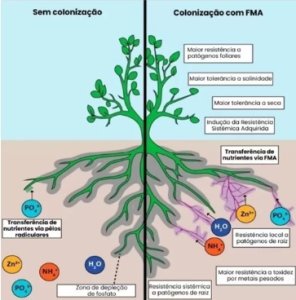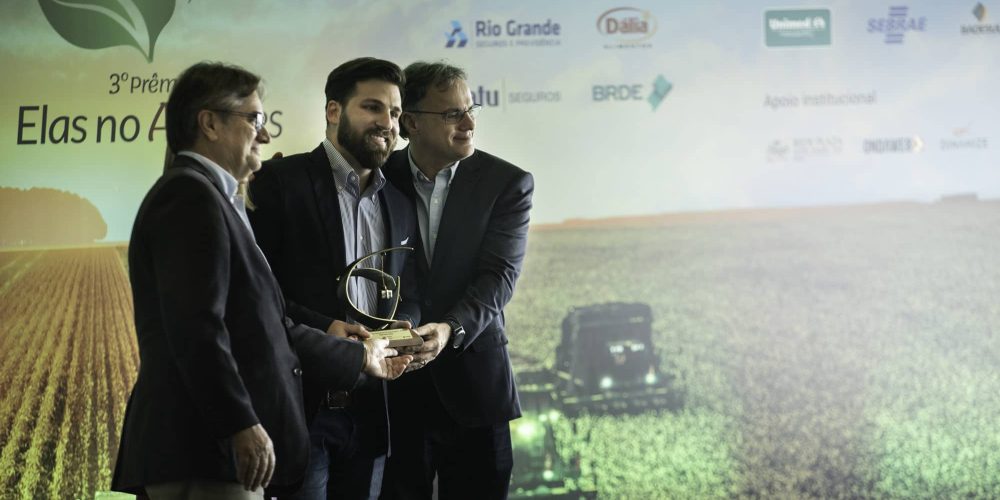Symbiotic interactions between the root system of plants and some fungi are commonly referred to as mycorrhizal associations. In these interactions, the mycelium of the fungus colonizing the root extends into the soil and absorbs water and nutrients (BARBOSA et al., 2015). On the other hand, the fungi benefit by using in their metabolism products fixed by the photosynthetic process of plants (WANG; QIU, 2006).
The term mycorrhiza was proposed by the German botanist Albert Bernard Frank in 1885, originating from the Greek in which “mico” means fungus and “riza” means roots (SOUZA et al., 2006). Approximately 90% of terrestrial plants form mycorrhizal associations, which were established more than 400 million years ago and are now found in almost all habitats in the world (BERUDE, et al., 2015). The increase in nutrient absorption capacity is promoted by the interaction of mycorrhizal fungi with plant species, providing several benefits, in addition to increasing the survival capacity of plants in the soil through the expansion of the root system, caused by the symbiosis of mycorrhizal fungi with the roots (MOREIRA & SIQUEIRA, 2006; BRAHMAPRAKASH & SAHU, 2012).
Mycorrhizae were originally classified into three groups, according to the morphological and anatomical aspect of root colonization: ectomycorrhiza, endomycorrhiza and ectoendomycorrhiza (GERDEMANN, 1968; LOPES et al., 1983 cited by RUSSOMANNO, 2006).
- Ectomycorrhiza: this group is characterized mainly by the formation of a fungal network (mycelium) around the cortex of short, thin roots, mainly in the region where root hairs form. This mycelium performs functions similar to those of root hairs and, as a result, there may be a reduction in their formation (Marx & Krupa 1978). These have a limited geographic and plant distribution. Their occurrence is predominant in temperate and cold regions and almost exclusively in woody plants, such as those of the genera Pinus and Eucalyptus, which are also found in Brazil. Ectomycorrhizal fungi are essential for the growth and development of these tree species and, consequently, for an increase in the productivity of forest species (DE MIRANDA, 1981).
- Ectoendomycorrhizae: they present characteristics of both groups. These fungi have little ecological importance and could be considered as a state of evolution between ectomycorrhizae and endomycorrhizae (DE MIRANDA, 1981).
- Endomycorrhizae: This group has a wider geographic and plant distribution than the others. The fungi responsible for this type of association occur in most soils, especially in tropical soils with low fertility, and infect most annual or perennial plants, including those of greater economic interest, such as corn, soybeans, wheat, citrus, coffee, cocoa and others (GERDEMANN 1975). They are often called arbuscular mycorrhizal fungi (AMF), in which the penetration of the internal mycelium into the root cortex occurs inter and intracellularly.
Arbuscular mycorrhizal fungi (AMF) belong to the subphylum Glomeromycotina (phylum Mucoromycota). They are obligate biotrophs, characterized by establishing a symbiotic and mutualistic relationship with plant roots (Figure 1), promoting gain of nutrients such as phosphorus (P) and nitrogen (N), zinc (Zn), copper (Cu) and iron (Fe) (SALA et al., 2022). The plants have greater tolerance to environmental stresses (drought, metals, pests, diseases, etc.), culminating in greater plant development and, consequently, greater productivity. In addition to direct benefits, AMF also generate a series of indirect benefits to the associative ecosystem.

Nutritional effects are the most evident and consistent of those attributed to mycorrhizae, and are directly related to plant growth and production. This fact results mainly from the direct action of the fungus in nutrient absorption and indirect action in the biological fixation of nitrogen, mineralization and/or solubilization of nutrients in the rhizosphere, as well as changes in the translocation, partitioning and efficiency of use of nutrients absorbed by the roots or mycorrhizae. Studies on various plant species in various parts of the world show that mycorrhizal plants generally absorb larger quantities of macro and micronutrients, as well as other elements such as Br, Cl, Na, Al, Si and heavy metals (MATOS, 1999).
Mycorrhizal symbiosis ensures host species adaptive success in soils with low fertility, as the fungus improves tolerance to acidity, toxicity from heavy metals and contributes to resistance to diseases present in the environment (FARIA et al., 2017).
Its cycle begins with the germination of spores, which form in the soil or inside the roots (SOUZA et al., 2011) when favorable environmental factors are detected by organisms, such as some compounds emitted by the roots or seeds of plants, thus the fungi are attracted, beginning their growth and branching of hyphae, nuclear division and colonization (COELHO, 2019).
The compatibility and specificity between AMF and host plants promote greater spore multiplication, mycorrhizal colonization, extraradical hyphae growth and soil protein production. AMF also benefit from receiving energy and carbon through the photosynthetic metabolism of plants (BARBOSA et al., 2019).
AMF actively participate in soil formation and structuring, act as important interveners in the accumulation of soil organic matter (OM), stimulate the metabolic activity of other soil microorganisms, providing greater homeostasis to the productive ecosystem (RILLIG; MUMMEY, 2006). Brazilian soils, especially in Cerrado areas, are characterized by being poor in nutrients, with phosphorus being one of the most difficult nutrients to work with, as it is immobile in the soil, which makes it difficult for plants to absorb it. The increasing use of phosphate fertilizers to correct the problem of low phosphorus availability has a strong economic and environmental impact, since the chemical processes for producing these fertilizers are expensive in terms of energy, in addition to using non-renewable and finite sources of energy (DE SOUZA MENDES, 2021).
Total soil phosphorus can be in organic or inorganic form, with organic phosphorus contributing up to 50% of the total phosphorus composition in soils, especially in no-tillage systems (GYANESHWAR et al., 2002). Organic phosphorus occurs mainly in the unavailable form of inositol phosphate (phytate) and others such as phosphomonoesters, phospholipids, nucleic acids, and phosphotriesters (GYANESHWAR et al., 2002), and can become available through mineralization by phosphatase enzymes released by roots and microorganisms (DE SOUZA MENDES, 2021). Knowledge and understanding of soil-plant interactions are increasingly important. And AMF are part of these interactions, playing a very important role in plant development (WAKELIN et al., 2004; VASSILEV et al., 2006).
Affinity of AZOGEL® matrix with mycorrhizal fungi
AZOGEL® it is an organic matrix produced from collagen with a high content of organic carbon and nitrogen that are available for the activity of microorganisms present in the soil and rhizosphere. In general, the number of microorganisms present in the rhizosphere is much greater than in a non-rhizosphere soil and their existence depends mainly on the organic compounds that the root exudes into the soil. In turn, the quality of the rhizosphere depends on a high availability of organic substances, such as carbon, which is the main element of soil organic matter. Thus, both nitrogen and other organic components present in high concentration in AZOGEL® contribute positively to adequate microbial development in the rhizosphere.
With the contribution of AZOGEL® in microbial development, including mycorrhizal fungi, the symbiotic relationship established between these microorganisms and plants, as previously discussed in the text, promotes greater use of nutrients by plants, which will result in greater development and productivity of crops.
References
BARBOSA, Julierme Zimmer et al. Beneficial bacteria and fungi in the plant endosphere. Agrogeoenvironmental Magazine, v. 7, n. 3, 2015.
BARBOSA, MV et al. Arbuscular mycorrhizal fungi and Urochloa brizantha: symbiosis and spore multiplication. Tropical Agricultural Research [online]. v. 49, e54530, 2019.
BERUDE, Marciana et al. Mycorrhizae and their agroecological importance. Encyclopedia Biosphere, v. 11, n. 22, 2015.
BERRUTI, A. et al. Arbuscular Mycorrhizal Fungi as natural biofertilizers: let's benefit from past successes. Frontiers in Microbiology, vol. 6, p. 1-13, 2015.
BRAHMAPRAKASH, GP; SAHU, PK Biofertilizers for sustainability. Journal of the Indian Institute of Science. v. 92, no. 1, p. 37-62, 2012.
COELHO, LCS et al. Seed exudates of Sesbania virgata (Cav.) Pers. stimulate the asymbiotic phase of the arbuscular mycorrhizal fungus Gigaspora albida Becker & Hall. Hoehnea [online]. v. 46, no. 1, e272018, 2019.
DE MIRANDA, Jeanne CC. Use of mycorrhizae in agriculture. 1981.
DE SOUZA MENDES, Adriano Augusto; MARTINS, Karla Vilaça. Phosphorus uptake potential by plants inoculated with arbuscular mycorrhiza. Perquirere, v. 2, n. 18, p. 82-87, 2021.
FARIA, AB de C. et al. Use of ectomycorrhizae in forest bioremediation. Forest Science [online]. 2017, v. 27, n. 1, p. 21-29, 2017.
GERDEMANN. JN Vesicular-arbuscular mycorrhizae. In: TORREY, GD & CLARKSON, DT, ed. The development and function of roots. London, Academic Press, 1975. p. 575-91.
GYANESHWAR, P. et al. Role of soil microorganisms in improving P nutrition of plants. Plant and Soil, The Hague, vol. 245, p. 83-93, 2002.
JACOTT, C.N.; MURRAY, J.D.; RIDOUT, CJ Trade-offs in arbuscular mycorrhizal symbiosis: disease resistance, growth responses and perspectives for crop breeding. Agronomy, vol. 7, article 75, 2017. DOI: 10.3390/agronomy7040075.
JEFFRIES, P. et al. The contribution of arbuscular mycorrhizal fungi in sustainable maintenance of plant health and soil fertility. Biology and Fertility of Soils, vol. 37, p. 1-16, 2003.
MARX, DH & KRUPA, SV Ectomycorrhizae. In: DOMMERGUES, YR & KRUPA, SV, ed. Interactions between non-pathogenic soil microorganisms and plants. Amsterdam, Elsevier, 1978. p. 373-400.
MATOS, RMB; DA SILVA, EMR; LIMA, E. Mycorrhizal fungi and plant nutrition. 1999.
MOREIRA, FS; SIQUEIRA, JO Soil microbiology and biochemistry. 2nd ed. Lavras: Ed. da UFLA, 2006.
RILLIG, MC; MUMMEY, DLMycorrhizas and soil structure. New Phytology, vol. 171, p. 41-53, 2006.
RUSSOMANNO, OMR Influence of arbuscular mycorrhizal fungi associated or not with Fusarium oxysporum Schecht. on rosemary (Rosmarinus officinalis L.) and basil (Ocimum basilicum L.) plants. 2006. 101f. Doctoral Thesis. PhD in Agronomy. São Paulo State University “Julio De Mesquita Filho”, Botucatu, SP, 2006.
SALA, HÉLIDA REGINA et al. The role of arbuscular mycorrhizal fungi in the tolerance of common beans to chromium. 2022. Dissertation (Master in Environment and Regional Development) – Universidade do Oeste Paulista – Unoeste, Presidente Prudente, SP, 2022.
SOUZA, LA de et al. Tolerance and phytoremediation potential of Stizolobium aterrimum associated with the arbuscular mycorrhizal fungus Glomus etunicatum in lead-contaminated soil. Brazilian Journal of Soil Science [online], v. 35, n. 4, p. 1441-1451, 2011.
SOUZA, VC; SILVA, RA; CARDOSO, GD; BARRETO, AF Studies on mycorrhizal fungi. Brazilian Journal of Agricultural and Environmental Engineering. v. 10, n. 3, p. 612-618, 2006.
VASSILEV, N.; MEDINA, A.; AZCÓN, R.; VASSILEVA, M. Microbial solubilization of rock phosphate on media containing agro-industrial wastes and effect of the resulting products on plant growth and P uptake. Plant Soil, vol. 287, p. 77-84, 2006.
WANG, B.; QIU, YL Phylogenetic distribution and evolution of mycorrhizas in land plants. My-corrhiza, Heidelberg, v.16, n.5, p.299-363, jul. 2006.
WAKELIN, SA et al. Phosphate solubilization by Penicilliumspp. closely associated with wheat roots. Biology and Fertility of Soils, vol. 40, p. 36-43, 2004.
Authors
Agr Eng. Dr. Angélica Schmitz Heinzen
Agricultural Eng. Msc. Carolina Custodio Pinto
Agricultural Eng. Msc. Thiago Stella de Freitas






